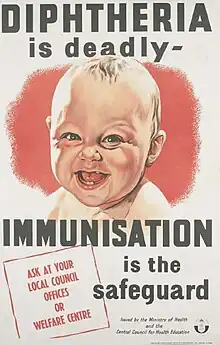


A toxoid is an inactivated toxin (usually an exotoxin) whose toxicity has been suppressed either by chemical (formalin) or heat treatment, while other properties, typically immunogenicity, are maintained.[1] Toxins are secreted by bacteria, whereas toxoids are altered form of toxins; toxoids are not secreted by bacteria. Thus, when used during vaccination, an immune response is mounted and immunological memory is formed against the molecular markers of the toxoid without resulting in toxin-induced illness. Such a preparation is also known as an anatoxin.[2] There are toxoids for prevention of diphtheria, tetanus and botulism.[3]
Toxoids are used as vaccines because they induce an immune response to the original toxin or increase the response to another antigen since the toxoid markers and toxin markers are preserved. For example, the tetanus toxoid is derived from the tetanospasmin produced by Clostridium tetani.[4] The latter causes tetanus and is vaccinated against by the DTaP vaccine. While patients may sometimes complain of side effects after a vaccine, these are associated with the process of mounting an immune response and clearing the toxoid, not the direct effects of the toxoid. The toxoid does not have virulence as the toxin did before inactivation.
Toxoids are also useful in the production of human antitoxins. Multiple doses of tetanus toxoid are used by many plasma centers in the United States for the development of highly immune persons for the production of human anti-tetanus immune globulin (tetanus immune globulin (TIG), HyperTet (c)[5]), which has replaced horse serum-type tetanus antitoxin in most of the developed world.
Toxoids are also used in the production of conjugate vaccines. The highly antigenic toxoids help draw attention to weaker antigens such as polysaccharides found in the bacterial capsule.[6]
List of toxoids
| Toxin | Organism | Toxoid |
|---|---|---|
| Tetanus toxin | Clostridium tetani | Tetanus toxoid |
| Diphtheria toxin | Corynebacterium diphtheriae | Diphtheria toxoid |
| Botulinum toxin | Clostridium botulinum | Botulinum toxoid |
| Pertussis toxin | Bordetella pertussis | "Bordetella pertussis toxoid antigen"[7] (see pertussis vaccine) |
| Tracheal cytotoxin | Bordetella pertussis | |
| Erythrogenic toxin | Streptococcus pyogenes | (PMID 10948118, 10925320) |
| Leukocidin, Streptolysins | Streptococcus pyogenes | |
| Clostridial a-toxin | Clostridial perfringens | (PMID 4306752) |
| Cholera toxin | Vibrio cholerae | [8](Used in experimental TA-CD) |
| Anthrax toxin | Bacillus anthracis | (see anthrax vaccines)[9] |
| Staphylococcal enterotoxin | Staphylococcus aureus | (PMID 30824769) |
| Toxic shock syndrome toxin | Staphylococcus aureus | (PMID 30824769) |
| Pseudomonas exotoxin A | Pseudomonas aeruginosa | (Unnamed; used in Vi-rEPA)[10] |
References
- ↑ Parham, P. (2015). "The Immune System". 4th Ed. Garland Science, Peter & Francis Group, LLC. New York.
- ↑ Anatoxin
- ↑ Moloney, P. J. (1926). "The Preparation and Testing of Diphtheria Toxoid (Anatoxine-Ramon)". American Journal of Public Health (PDF). 16 (12): 1208–1210. doi:10.2105/AJPH.16.12.1208. PMC 1321494. PMID 18012024.
- ↑ "Diphtheria and Tetanus Toxoids Adsorbed" (PDF). fda.gov. Retrieved 21 October 2015.
- ↑ "Tetanus Immune Globulin (Human)" (PDF). September 2012. Archived from the original (PDF) on 4 March 2016. Retrieved 2010-05-29.
- ↑ Vaccine design : innovative approaches and novel strategies. Rappuoli, Rino., Bagnoli, Fabio. Norfolk, UK: Caister Academic. 2011. ISBN 9781904455745. OCLC 630453151.
{{cite book}}: CS1 maint: others (link) - ↑ "Bordetella pertussis toxoid antigen (formaldehyde, glutaraldehyde inactivated)". go.drugbank.com.
- ↑ Germanier, R; Fürer, E; Varallyay, S; Inderbitzin, TM (June 1976). "Preparation of a purified antigenic cholera toxoid". Infection and Immunity. 13 (6): 1692–8. doi:10.1128/iai.13.6.1692-1698.1976. PMC 420821. PMID 823107.
- ↑ "NIBSC - Anthrax". www.nibsc.org.
It can be prevented by vaccination, and the licensed anthrax vaccine is a toxoid vaccine. It consists of inactivated subunits of anthrax toxin and elicits an antibody response that neutralises anthrax toxin.
- ↑ Kossaczka Z, Bystricky S, Bryla DA, Shiloach J, Robbins JB, Szu SC (June 1997). "Synthesis and immunological properties of Vi and di-O-acetyl pectin protein conjugates with adipic acid dihydrazide as the linker". Infection and Immunity. 65 (6): 2088–93. doi:10.1128/IAI.65.6.2088-2093.1997. PMC 175288. PMID 9169736.